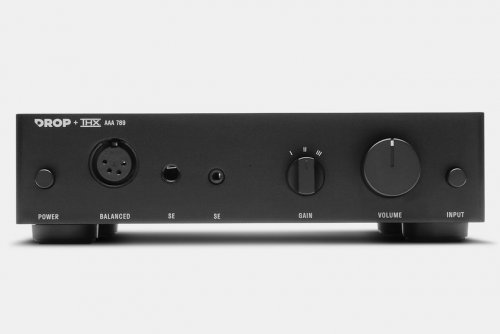Hi all
i thought I’ll chime in on this discussion for what it’s worth. I have owned the THX AAA 789 for two months. I bought it out of curiosity having read / watched all the reviews. My other headphone amp is the Rupert Neve RNHP, itself a well regarded amp. I have 4 pairs of headphones that I’ve used with both amps. Audio Technica M50x, Audio Technica ATH-R70x, AKG K271 mk2 and Beyerdynamic DT990. Firstly to clear up the issue of the Massdrop vs Drop discussion. They are identical apart from the change of branding and the silk screen printing on the casework. Secondly, regarding the question of whether or not the amp is truly balanced and whether there is any value to using the XLR pathway through the amp. As previously quoted elsewhere on the thread, in absolute terms the amp is not a true differential circuit throughout but certain elements of the circuit employ some of those design elements which result in similar benefits in the signal path e.g. lower noise floor, less distortion and higher output voltage via the XLR output. My assessment of this amp in use via its single ended pathway is that it is has a transparent signature and will easily drive easier loads to high levels, using the high gain switch. The XLR output as the specs suggest has a much higher output level than the SE outputs. Output via XLR headphone out when used in conjunction with the XLR inputs is significantly louder and more muscular that that of SE although the sound signature remains the same. The benefit therefore of using the XLR throughput is purely the ability to easily drive more demanding loads and gives the option of reducing the gain if desired. This does leave more headroom on the volume adjustment. Curiously I have also found that when the SE input is used but the headphones are connected to the XLR output the output level is higher than when using the SE output but slightly quieter than if the XLR input is used in conjunction with the XLR output. In absolute terms I find this to be one of the better headphone amps that I have used. It is very linear and transparent and hugely powerful (via XLR). By comparison to the Rupert Neve amp is it more analytical in presentation and less fluid. Instruments tend to sound thinner and uncoloured. Soundstage is narrower than something like the Neve or a tube amp. To my mind headphone choice is important as the 789 will present the headphone’s sound signature as the manufacturer intended. The only criticism that I have is that on high gain with the volume turned right down the sound is still audible, but that’s not an issue for me. Some have commented on channel imbalance on the volume control but my unit is perfect in that respect. I have experimented with different psu’s but they made no difference to my ears. Accompanying equipment is either Quad Artera CDP / DAC or the Artera used as a CD transport into the SMSL SU-9 DAC via a Cardas 50ohm coax cable. My preferred partnering headphone is the ATH-R70x.
I hope that helps.





























